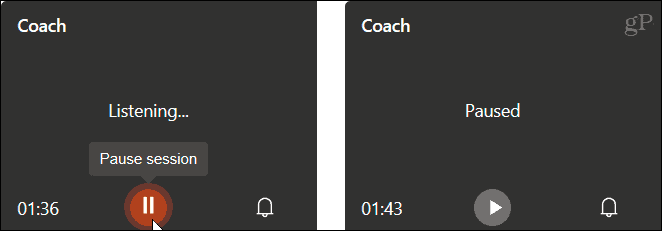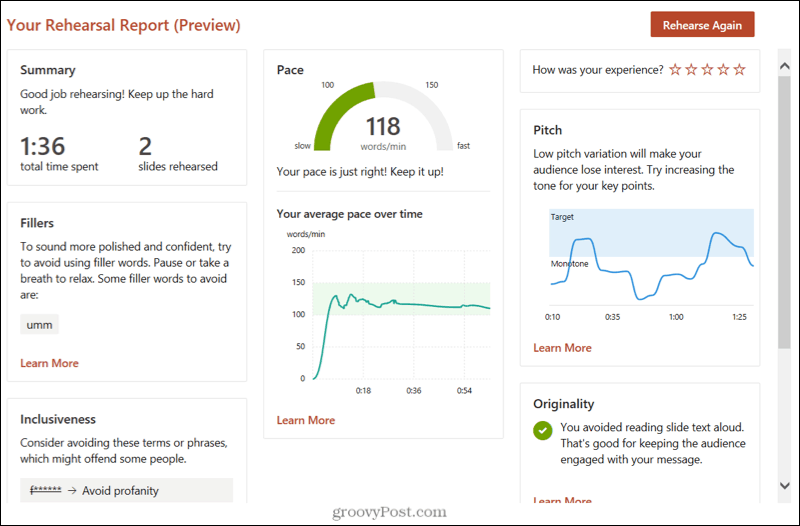With Presenter Coach, you rehearse your slideshow and receive feedback. You’ll see tips on the screen during your rehearsal and can then review a full report afterwards. This is a great way to make sure you’re prepared and ready to roll when you start your presentation for real.
PowerPoint Presenter Coach Requirements
Before you use Presenter Coach in PowerPoint, review these items to make sure you have everything you need.
A microphone in your computerAn internet connectionA Microsoft accountA quiet place to rehearse
Presenter Coach is available with PowerPoint for Microsoft 365 on Windows and Mac, and PowerPoint for the web, Android tablets, and iPad.
How to Use Presenter Coach
If you’re ready to start rehearsing your slideshow, open your PowerPoint presentation and follow these steps.
As you rehearse your show, you’ll see feedback like pace, pitch, filler words, and even if you toss in profanity. You can disable this option by clicking the bell icon in the dialog box and simply review the report at the end. However, the real-time feedback can be helpful as you talk through the presentation.
To pause the Presenter Coach, put your cursor over the microphone icon in the dialog box and click when it changes to a pause button. Click the play button to resume.
When you finish, exit the full-screen view for your show by right-clicking and picking End Show or pressing your Escape key.
Review Your Rehearsal Report
Once you finish using Presenter Coach, your Rehearsal Report will automatically appear. You cannot minimize or save the report. And you cannot reopen it once you close it. So if you’d like to keep a copy of it, consider grabbing a screenshot.
If you use the real-time feedback, you’ll notice a few of those same suggestions appear in the report along with other details. Start by reviewing your total time and number of slides rehearsed in the Summary section. Then move onto the following information.
Pace: Speak at an even pace; neither too fast nor too slow.Fillers: If you hesitate while speaking and use a filler word, for example, “umm,” the report notes this. Try to speak with confidence and without hesitation.Inclusiveness: Avoid sensitive phrases related to age, race, gender, profanity, or disability.Repetitive Language: Some people repeat words or phrases as they tell a story without even realizing it. Try to avoid repeating words like “basically” or technically.”Pitch: Increase your tone of voice for keywords or points to keep your audience more interested.Originality: Speak beyond your slide content. If you simply read the exact text on each slide, your audience can lose interest. Instead, summarize or expand on what your slides show.
For more details on these suggestions and more recommendations, check out the Microsoft Support page on Suggestions for Presenter Coach.
Be Prepared with Presenter Coach in PowerPoint
The Presenter Coach in PowerPoint is a terrific tool to help you speak more confidently, concisely, and correctly when presenting a slideshow. Don’t forget about this built-in feature when it’s time to rehearse your next presentation! For other handy things you can do, look at how to create a screen recording in PowerPoint or how to add speaker notes to your PowerPoint presentation.
![]()






